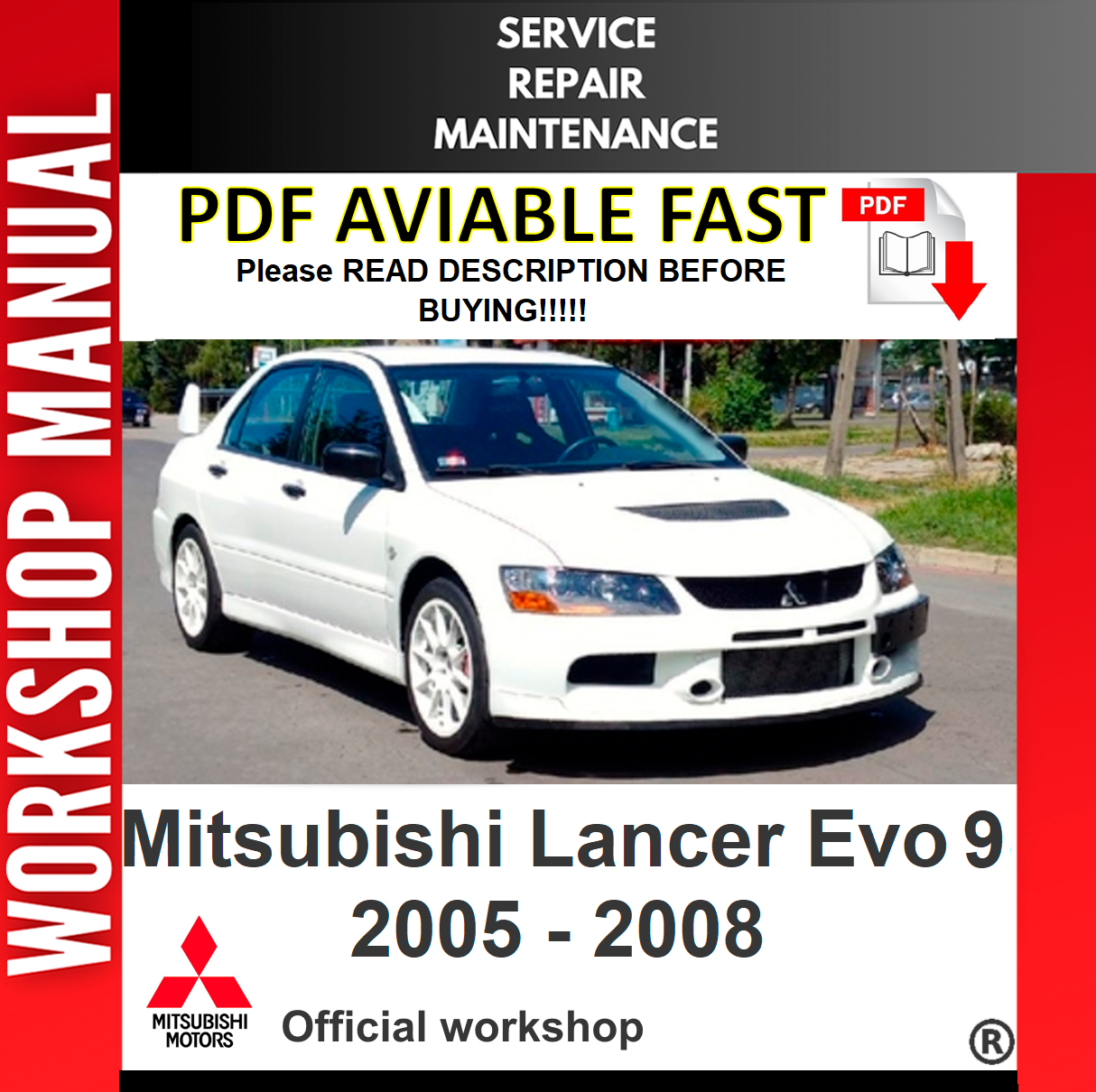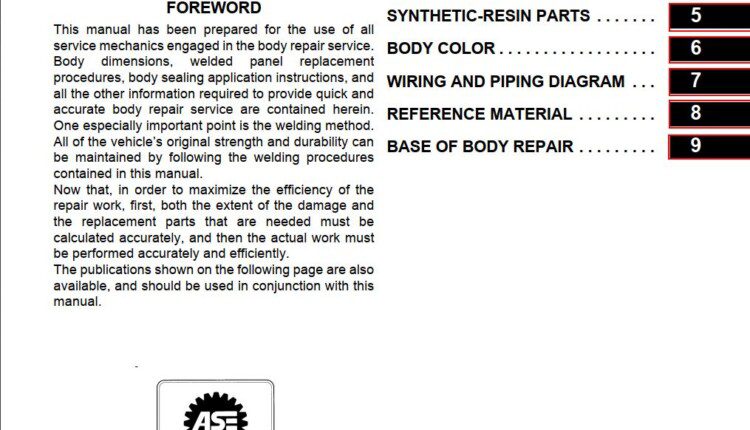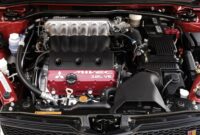Mitsubishi Lancer Evolution repair manual free download – Mitsubishi Lancer Evo repair manual free download? Sounds tempting, right? But before you click that download button, hold on! This isn’t just about wrenching on your ride; it’s a deep dive into the legal minefield of copyrighted material, the murky waters of online resources, and the crucial differences between a freebie and a professional manual. We’ll spill the beans on finding legit sources, spotting dodgy downloads, and making sure your Evo stays purring like a kitten, not sputtering like a dying dinosaur.
This guide navigates the tricky terrain of finding free Mitsubishi Lancer Evolution repair manuals online. We’ll examine the legal implications of downloading copyrighted content, explore the reliability of various online sources, and detail the essential information found within a typical repair manual. We’ll also walk you through specific repair procedures, troubleshoot common problems, and highlight the importance of using the right tools and safety gear.
Get ready to become your own Evo mechanic – responsibly!
Legality and Copyright of Free Downloads
Downloading a Mitsubishi Lancer Evolution repair manual for free might seem appealing, but it’s crucial to understand the legal implications. Ignoring copyright laws can lead to serious consequences, impacting both individuals and businesses. This section clarifies the legal landscape surrounding the download of copyrighted material and offers guidance on accessing repair information legitimately.Copyright infringement is a serious offense.
Repair manuals, like any other creative work, are protected by copyright law. This means that the creator (typically the manufacturer, in this case, Mitsubishi) holds exclusive rights to reproduce, distribute, and display their work. Downloading and using a copyrighted repair manual without permission constitutes copyright infringement.
Legal Ramifications of Downloading Copyrighted Repair Manuals
The penalties for copyright infringement can be substantial. These can range from a simple cease-and-desist letter to hefty fines and even legal action. The severity of the consequences depends on factors such as the scale of the infringement (e.g., personal use vs. commercial distribution) and the copyright holder’s response. In the case of Mitsubishi Lancer Evolution repair manuals, the manufacturer might pursue legal action against individuals or websites distributing unauthorized copies.
This could result in significant financial penalties and legal fees.
Consequences of Copyright Infringement
Beyond legal repercussions, downloading illegal copies of repair manuals can have other negative consequences. These unauthorized copies often lack accuracy and completeness, potentially leading to incorrect repairs and further damage to your vehicle. Furthermore, relying on unreliable information could compromise your safety and the safety of others. In addition, supporting illegal distribution undermines the efforts of legitimate publishers and creators who invest time and resources in producing accurate and reliable repair information.
Legitimate Sources for Obtaining Mitsubishi Lancer Evolution Repair Information
Several legitimate sources offer accurate and complete Mitsubishi Lancer Evolution repair information. These include authorized Mitsubishi dealerships, reputable online retailers specializing in automotive repair manuals, and specialized automotive libraries. Dealerships often have access to the most up-to-date information directly from the manufacturer. Online retailers like Amazon or eBay may offer officially licensed manuals, though it’s crucial to verify the seller’s authenticity.
Alternatively, some specialized automotive libraries may possess hard copies or digital versions of the manuals.
Differences Between Free and Paid Repair Manuals
The most significant difference between free and paid repair manuals lies in their accuracy and completeness. Paid manuals are typically created by professionals, rigorously reviewed, and regularly updated to ensure accuracy. Free manuals, on the other hand, are often incomplete, inaccurate, or outdated. They may contain errors that could lead to incorrect repairs and potential damage to your vehicle.
The difference in quality directly reflects the investment made in their creation and maintenance. A paid manual provides peace of mind knowing that you’re working with reliable information, while a free manual presents a considerable risk. This risk is compounded by the potential legal issues associated with obtaining it illegally.
Availability of Free Repair Manuals Online
Finding free Mitsubishi Lancer Evolution repair manuals online is a common quest for car enthusiasts and DIY mechanics, driven by the desire to save money and gain hands-on experience. However, navigating this digital landscape requires caution, as the availability and reliability of these resources vary significantly. The ease of access often comes with inherent risks that need careful consideration.The internet offers a mixed bag of sources for these manuals.
Some dedicated automotive forums and websites specialize in sharing repair information, while others host them as part of a broader collection of downloadable materials. Peer-to-peer file-sharing networks also sometimes contain these manuals, although their legality and safety are often questionable. The quality and completeness of these manuals differ greatly depending on their origin and the expertise of the person who created or uploaded them.
Websites and Forums Offering Free Manuals
Several online communities and websites cater to car enthusiasts, some of which may offer free Mitsubishi Lancer Evolution repair manuals. These range from specialized forums dedicated to specific car models to broader automotive communities. However, it’s crucial to understand that the quality and accuracy of these manuals are not guaranteed. Some may be incomplete, outdated, or even contain inaccurate information that could lead to improper repairs.
Examples include sites like some dedicated car forums (whose names we avoid mentioning to prevent unintended promotion of potentially unreliable sources), and some general automotive repair websites that may host user-submitted content.
Risks Associated with Downloading from Unreliable Sources
Downloading repair manuals from unreliable sources presents several potential risks. These include the risk of downloading corrupted or incomplete files, which can be frustrating and time-consuming. More seriously, downloading from untrusted sites may expose your computer to malware or viruses. This can lead to data loss, system instability, and even identity theft. Additionally, some downloaded manuals might contain inaccurate or misleading information, potentially leading to incorrect repairs and further damage to the vehicle.
For instance, a faulty wiring diagram could lead to electrical shorts or damage to sensitive components. Using an incomplete manual could result in missing crucial steps, leading to incomplete or faulty repairs.
Comparison of Manual Quality and Completeness
The quality and completeness of free repair manuals vary dramatically. Professionally produced manuals, even if not free, are generally far more comprehensive and accurate. They often include detailed diagrams, step-by-step instructions, and troubleshooting guides. Free manuals found online, however, might lack these features and may contain errors or omissions. The language used might also be inconsistent or difficult to understand.
Finding a free Mitsubishi Lancer Evolution repair manual download can be a lifesaver for DIY mechanics. However, understanding the intricacies of Mitsubishi engines is crucial, and sometimes issues crop up even in seemingly unrelated models. For instance, if you’re facing challenges, learning about potential Mitsubishi Eclipse Cross engine problems and solutions might offer valuable insights applicable to other Mitsubishi vehicles.
This cross-referencing knowledge can ultimately enhance your ability to tackle repairs on your Lancer Evolution, saving you time and money.
Some free manuals might cover only specific aspects of the repair process, leaving out crucial details. Conversely, some free manuals, especially those created by experienced mechanics and shared within trusted communities, can be quite accurate and detailed. The key is careful vetting and source verification.
Red Flags Indicating Unreliable Downloads
Several red flags can indicate that a download source for repair manuals is unreliable or potentially harmful. These include websites with poor design, excessive pop-up ads, or suspicious domain names. Lack of contact information or a privacy policy should also raise concerns. A website that offers a vast array of copyrighted material for free is highly suspect.
Furthermore, if the download requires excessive personal information or payment after initially claiming to be free, it is likely a scam. Finally, negative user reviews or comments on the site or download should serve as a strong warning. Any download that triggers your antivirus software should be immediately aborted.
Content and Structure of a Typical Repair Manual

A Mitsubishi Lancer Evolution repair manual, whether free or paid, serves as a comprehensive guide for maintaining and repairing this high-performance vehicle. Understanding its structure and content is crucial for anyone undertaking DIY repairs. The organization typically follows a logical flow, grouping information by vehicle systems.
Typical Sections in a Repair Manual
Repair manuals are systematically organized to provide easy access to specific repair information. Common sections include those dedicated to the engine, transmission, braking system, electrical system, suspension, and bodywork. Each section is further broken down into specific components, detailing their function, maintenance procedures, and troubleshooting steps. Detailed diagrams and specifications are integral to each section, enhancing understanding and aiding in repair processes.
Information Included in Each Section
Each section within the manual provides a wealth of information vital for successful repairs. For example, the engine section will include details on engine removal and installation, specifications for fluids and lubricants, timing belt replacement procedures, and troubleshooting guides for common engine problems. Similarly, the braking system section will cover brake pad and rotor replacement, caliper servicing, ABS system diagnostics, and master cylinder repair.
Clear diagrams, precise specifications, and step-by-step instructions are essential features across all sections. Troubleshooting sections often involve flowcharts or decision trees to guide the user through diagnosis.
Sample Braking System Table
The following table illustrates the organization of information within a typical manual section, using the braking system as an example. The table’s responsive design ensures readability across various devices.
| System | Component | Procedure | Diagram Reference |
|---|---|---|---|
| Braking System | Brake Pad Replacement | Remove wheel, caliper, and old pads; install new pads; bleed brakes. | Figure 3-12 |
| Braking System | Brake Rotor Resurfacing | Remove rotor; machine rotor to specifications; reinstall rotor. | Figure 3-15 |
| Braking System | Brake Fluid Flush | Open bleeder valves; pump brake pedal; refill master cylinder. | Figure 3-18 |
| Braking System | ABS Sensor Inspection | Inspect sensor for damage; check wiring connections; test sensor resistance. | Figure 3-21 |
Comparison of Free and Paid Manuals
The information presented in free and paid repair manuals differs significantly in terms of comprehensiveness, clarity, and accuracy.
| Feature | Free Manual | Paid Professional Manual |
|---|---|---|
| Comprehensiveness | Often incomplete; may lack detailed diagrams or specifications. | Extremely detailed; covers all aspects of repair and maintenance. |
| Clarity | May contain ambiguous language or unclear diagrams. | Uses clear, concise language and high-quality diagrams. |
| Accuracy | May contain errors or outdated information. | Rigorously reviewed and updated; ensures accuracy. |
| Troubleshooting | Limited troubleshooting guides; may lack detailed diagnostic procedures. | Extensive troubleshooting sections with detailed diagnostic flowcharts and codes. |
| Diagrams | Often low-resolution, blurry, or incomplete diagrams. | High-resolution, clear, and detailed diagrams with multiple views. |
Specific Repair Procedures for the Mitsubishi Lancer Evolution: Mitsubishi Lancer Evolution Repair Manual Free Download

This section delves into the specifics of common repair procedures for the Mitsubishi Lancer Evolution, providing step-by-step guides and troubleshooting advice. Understanding these procedures can significantly enhance your ability to maintain and repair your Evo, saving you time and money in the long run. Remember always to prioritize safety and consult a qualified mechanic if you are unsure about any procedure.
Spark Plug Replacement
Replacing spark plugs is a routine maintenance task crucial for optimal engine performance. Neglecting this can lead to misfires, reduced fuel efficiency, and even engine damage. The following steps Artikel the process for a typical Lancer Evolution:
- Disconnect the negative terminal from the battery. This is a vital safety precaution to prevent electrical shocks.
- Locate the spark plugs. They are typically found on the top of the engine, often under a plastic cover. Consult your owner’s manual for the exact location.
- Remove the spark plug wires. Each wire is connected to a specific spark plug; carefully note their positions to avoid misconnections during reassembly. Use a spark plug wire puller tool to avoid damaging the wires.
- Remove the spark plugs using a spark plug socket. This requires a socket of the correct size and a ratchet. Apply even pressure to avoid stripping the threads.
- Inspect the old spark plugs. Check for excessive wear, fouling, or damage. This visual inspection can provide valuable insights into the engine’s health.
- Install the new spark plugs. Hand-tighten them initially, then use the socket and ratchet to tighten them to the manufacturer’s specified torque. Over-tightening can damage the spark plugs or engine threads.
- Reconnect the spark plug wires, ensuring each wire is securely attached to the correct spark plug.
- Reconnect the battery’s negative terminal.
- Start the engine and check for any misfires or unusual noises.
Diagnosing an Engine Misfire
An engine misfire is characterized by rough running, hesitation, and potentially a loss of power. Diagnosing the cause requires a systematic approach.The first step is to check for any readily apparent issues, such as loose spark plug wires or a damaged air intake system. A visual inspection often reveals obvious problems.Next, a scan tool capable of reading Diagnostic Trouble Codes (DTCs) should be used.
Finding a free Mitsubishi Lancer Evolution repair manual online can be a game-changer for DIY mechanics. But before diving into complex repairs, consider fuel efficiency – a key factor in overall car ownership. Check out these Mitsubishi Mirage fuel efficiency real world tests to see how smart maintenance can impact your bottom line. Understanding both your Evo’s mechanics and your fuel economy will keep you rolling smoothly and save you money in the long run.
The DTCs provide valuable clues to the source of the misfire. For example, a code indicating a misfire in cylinder 3 points towards a problem with that specific cylinder’s components (spark plug, ignition coil, injector, etc.).Further diagnostics might involve testing the ignition system (spark plugs, ignition coils, and wires), fuel system (fuel injectors and pressure), and compression in each cylinder.
Specialized tools like a compression tester are often needed for these tests.
Interpreting Diagnostic Trouble Codes (DTCs)
DTCs are numerical codes that indicate specific problems within the vehicle’s computer system. Each code corresponds to a particular fault. For example, a code like P0300 indicates a random/multiple cylinder misfire, while a code like P0171 might suggest a lean condition in bank 1. A comprehensive DTC lookup guide specific to the Mitsubishi Lancer Evolution model year is essential for accurate interpretation.
These guides are often available online or through automotive repair software.
Tips and Tricks for Successful Repair Procedures
Always disconnect the negative battery terminal before starting any electrical work. This is crucial for safety and prevents accidental short circuits.Use the correct tools for each job. Improper tools can damage components and lead to further problems. Invest in a good quality set of tools appropriate for automotive repair.Consult a repair manual specific to your Lancer Evolution’s model year and engine type.
This manual provides detailed diagrams, specifications, and torque values crucial for successful repairs.Work in a well-lit and ventilated area. Proper lighting and ventilation ensure safety and improve visibility.Take your time and work methodically. Rushing can lead to mistakes and potentially damage components. Thoroughness is key to successful repair procedures.Clean up your workspace after completing the repair. This ensures a safe and organized working environment.
Tools and Equipment Required for Repairs
Working on your Mitsubishi Lancer Evolution requires the right tools. Improper tools can lead to damage, injury, and frustrating delays. This section Artikels essential tools and equipment, emphasizing safety and proper usage. Remember, consulting your owner’s manual is crucial for specific torque specifications and procedures.
Essential Hand Tools
A well-equipped toolbox is fundamental for most Lancer Evolution repairs. Having the correct tools readily available streamlines the repair process and minimizes the risk of damage.
- Metric socket set (ranging from 8mm to 24mm, including deep sockets): Essential for removing and installing various bolts and nuts throughout the vehicle.
- Wrench set (both open-end and combination wrenches): Provides alternative access to fasteners, especially in tight spaces.
- Screwdriver set (Phillips and flathead, various sizes): For removing screws securing trim panels, covers, and other components.
- Pliers (needle-nose, slip-joint, locking): Useful for gripping small parts, bending wires, and performing other tasks.
- Hammer: For various tasks, from removing stubborn parts to installing components.
- Torque wrench: Crucial for tightening bolts and nuts to the manufacturer’s specified torque settings, preventing damage to components.
- Jack and jack stands: For safely lifting the vehicle during repairs. Never work under a vehicle supported only by a jack.
- Wheel chocks: Essential for preventing the vehicle from rolling while jacked up.
Specialized Tools for Lancer Evolution Repairs
Beyond basic hand tools, certain repairs may necessitate specialized equipment. Investing in these tools can significantly improve the efficiency and quality of repairs.
- Timing belt tools: Specific tools are required for replacing the timing belt, a crucial maintenance task on the Lancer Evolution. These tools ensure proper alignment and prevent damage to the engine.
- Wheel bearing press: Facilitates the removal and installation of wheel bearings without damaging the components.
- Fuel line disconnect tool: Safely disconnects fuel lines, preventing leaks and ensuring proper reconnection.
- Strut compressor: Compresses the struts to allow for easier spring and strut assembly removal and installation.
Safety Equipment
Safety should always be the top priority when performing any vehicle repair. Neglecting safety can lead to serious injury.
- Safety glasses: Protect your eyes from flying debris.
- Gloves: Protect your hands from grease, oil, and sharp edges.
- Work boots: Provide protection for your feet.
- Proper ventilation: Working in a well-ventilated area is essential to avoid inhaling harmful fumes from chemicals and engine exhaust.
- Fire extinguisher: Keep a fire extinguisher readily accessible in case of a fire.
Consequences of Using Improper Tools or Equipment
Using improper tools or equipment can lead to several negative consequences, including:
- Damaged parts: Incorrect tools can strip bolts, damage threads, or otherwise harm vehicle components.
- Injury: Improper tools can slip, leading to injuries to your hands or other body parts.
- Incomplete or faulty repairs: Improper tools may prevent you from completing a repair properly, leading to further problems.
- Increased repair costs: Damaging parts due to using the wrong tools will increase the overall cost of the repair.
Troubleshooting Common Problems
The Mitsubishi Lancer Evolution, while a high-performance machine, isn’t immune to issues. Understanding common problems and their solutions is crucial for maintaining its performance and longevity. This section details some frequently encountered problems, their causes, and effective troubleshooting steps. Remember, always consult your repair manual for detailed specifications and safety precautions before attempting any repairs.
Engine Starting Issues
Difficulty starting the Lancer Evolution can stem from several sources. A dead battery, faulty starter motor, or problems within the ignition system are prime suspects. Ignoring these issues can lead to complete engine failure or leave you stranded. Addressing these problems promptly is essential for maintaining vehicle reliability.
- Check the Battery: Verify battery voltage using a multimeter. A reading below 12.6 volts indicates a weak battery requiring charging or replacement.
- Inspect the Starter Motor: Listen for clicking sounds when attempting to start. A clicking sound often points to a faulty starter motor or low battery voltage. Visual inspection for loose connections or damage is also recommended.
- Test the Ignition System: Check for spark at the spark plugs. A lack of spark suggests issues with the ignition coil, distributor (if applicable), or crankshaft position sensor.
Turbocharger Problems, Mitsubishi Lancer Evolution repair manual free download
The Lancer Evolution’s turbocharger is a key component contributing to its performance. However, turbocharger issues, such as turbo lag, excessive smoke, or unusual noises, are common. Neglecting these can lead to significant engine damage. Early detection and appropriate action are vital.
- Turbo Lag: This refers to a delay in the turbocharger’s response to the accelerator. Causes can include a faulty boost pressure sensor, clogged air filter, or leaks in the intake system. Check these components for proper function and replace or clean as needed.
- Excessive Smoke: Blue smoke indicates burning oil, usually due to worn piston rings or a failing turbocharger seal. Black smoke suggests a rich fuel mixture, potentially caused by a faulty mass airflow sensor or fuel injectors. White smoke often signifies coolant leakage into the cylinders, requiring immediate attention.
- Unusual Noises: Whistling or whining sounds often indicate a failing turbocharger bearing. A knocking sound might suggest internal damage within the turbocharger itself. These noises warrant professional inspection and likely replacement of the turbocharger.
Transmission Problems
Transmission problems can range from minor shifting issues to complete transmission failure. These problems can significantly impact drivability and safety. Early diagnosis and repair are essential to avoid further damage.
- Difficult Shifting: This can be caused by low transmission fluid, worn clutch components (manual transmission), or internal transmission problems. Check the transmission fluid level and condition. If low, replenish with the correct type of fluid. If the fluid is dirty or burnt, a complete transmission fluid change may be necessary.
- Slipping Gears: This often indicates worn clutch plates (manual transmission) or problems within the automatic transmission’s internal components. This necessitates a professional inspection and likely a significant repair or replacement.
- Noisy Transmission: Grinding or whining noises point towards worn gears or bearings within the transmission. Ignoring these noises can lead to catastrophic transmission failure.
No-Start Condition Troubleshooting Flowchart
Start -> Check Battery Voltage (Multimeter) -> Voltage < 12.6V? -> Yes: Charge/Replace Battery -> No: Proceed -> Check Starter Motor (Listen for Clicking, Inspect for Damage) -> Clicking Sound? -> Yes: Check Battery Voltage & Connections -> No: Test Ignition System (Spark at Spark Plugs) -> Spark Present? -> Yes: Check Fuel System -> No: Replace Ignition Components -> Engine Starts? -> Yes: Done -> No: Seek Professional Assistance


